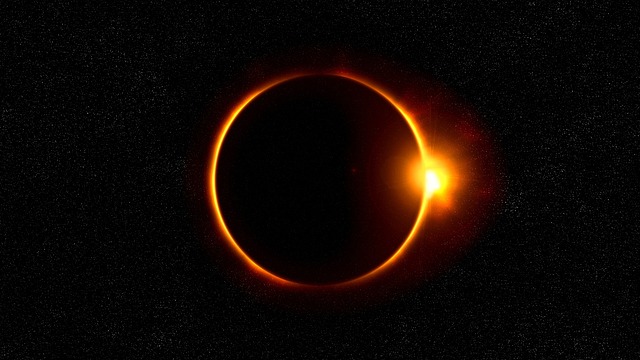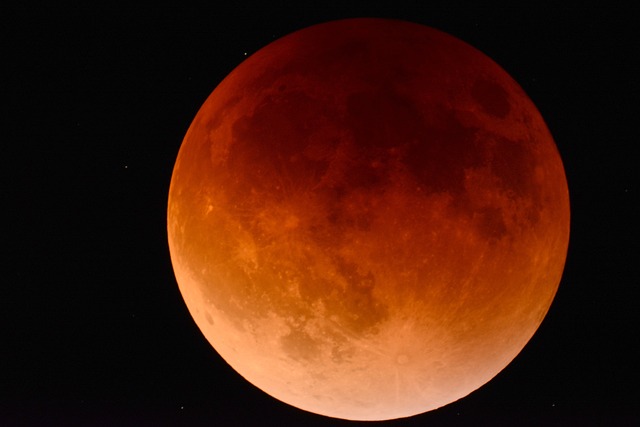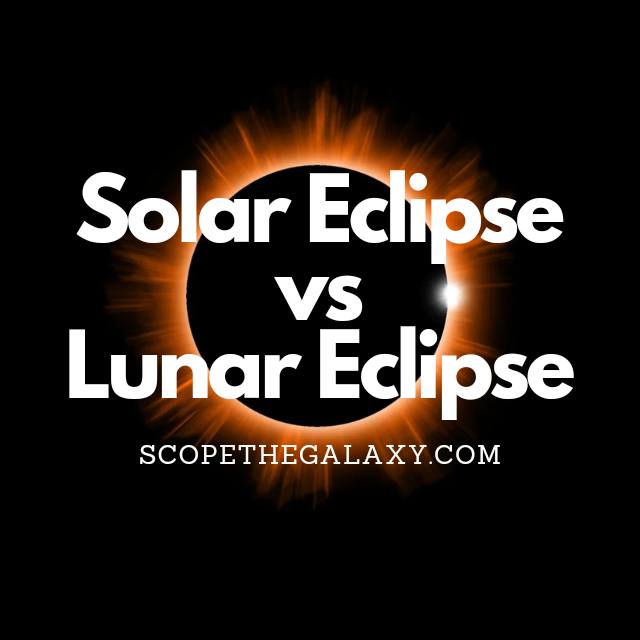*This post may contain affiliate links. This means we may make a commission if you purchase an item using one of our links*
Solar eclipses happen when our Moon block light from the Sun and casts a shadow over the Earth. In contrast, a lunar eclipse causes the Moon to dim as the Earth blocks out the sunlight that reaches its surface.
Discover the different types of eclipses we can experience and how each one happens. Learn the similarities and differences between solar and lunar eclipses and why eclipses of the Sun are so much rarer.
What Is A Solar Eclipse?
Table of Contents

A solar eclipse happens when the Moon blocks the light from the Sun and casts a shadow over the Earth. These events only happen during the new Moon phase, when this celestial body travels between the Sun and the Earth.
A total solar eclipse only happens when the Moon sits in perfect alignment with the Sun, casting a complete shadow on Earth, otherwise we experience a partial eclipse (where only part of the Sun is blocked by the Moon).
When the Moon passes in front of the Sun, it creates a shadow on part of the Earth. As our planet rotates, this shadow creates a path called the path of totality.
If you’re within the path of totality when the eclipse happens, the Sun’s light will disappear for a few minutes. This turns the sky dark even during the daytime, which can confuse animals and people who don’t know what is happening. Still, it allows scientists to study the Sun’s atmosphere more closely.
The Sun’s atmosphere, also known as the corona, is usually much dimmer than the Sun’s light, which makes it hard for scientists to see. But, when a solar eclipse occurs, the only light we can see is from the corona.
Solar eclipses don’t often happen over populated land. Still, on the rare occasions that they do, we can enjoy the experience of seeing the streams and ribbons our the Sun’s atmosphere.
We’re lucky to witness solar eclipses at all, as they require a specific mix of time and celestial mechanics. Think about it – the Sun has a monumental diameter of 1,392,000 km, while the Moon’s diameter is just 3,475 km. In addition, the Moon moves away from Earth at a rate of around 4 cm per year.
But, at this specific time, our Moon is exactly the right distance from Earth – in comparison to the Sun – that the two appear to be the same size as we view them from Earth. And this is why we experience solar eclipses.
What Is A Lunar Eclipse?

Lunar eclipses occur when Earth passes between the Moon and the Sun, which causes a shadow to fall on the former. These eclipses occur when the Moon is at full phase and are visible for half of the Earth. When this happens, Earth’s shadow can dim the Moon’s brightness or cause the lunar surface to take on a striking shade of red.
Lunar eclipses come in three types: total eclipses, partial eclipses, and penumbral eclipses. During a total eclipse of the Moon, this lunar body travels into the umbra (the inner part of Earth’s shadow)
When this happens, some color can pass through Earth’s atmosphere and reach the Moon’s surface. Short color wavelengths scatter more easily, such as violet and blue, while longer wavelengths, such as red, make it through. The more clouds or dust in Earth’s atmosphere at the time of the eclipse, the deeper shade of red the Moon turns.
A partial lunar eclipse occurs when the alignment of the Earth, the Moon, and the Sun is imperfect. When this happens, a shadow grows across part of the Moon but recedes before covering it entirely.
A penumbral eclipse occurs when the Moon passes through the Earth’s penumbra (rather than the umbra), and this faint outer atmosphere casts only a dim shadow. Penumbral eclipses often go unnoticed unless you know they’re happening.
Lunar eclipses are relatively common and occur around three times every year. Scientists estimate that roughly 29% of these eclipses are total lunar eclipses, usually lasting for a few hours. No matter where you are on Earth, you should witness a lunar eclipse once every two-and-a-half years.
How Are Solar And Lunar Eclipses Similar?
Solar and lunar eclipses are similar because they both occur when the Sun, Moon, and Earth line up so that one casts a shadow on another. These processes both rely on specific celestial mechanics that allow the Moon to appear precisely the same size as the Sun and thus create a perfect alignment for shadowing.
Differences Between A Solar Eclipse And Lunar Eclipse
- Lunar eclipses are a relatively common occurrence – no matter where you are on Earth, you will have the chance to witness this phenomenon once every two-and-a-half years (on average). In contrast, a total solar eclipse occurs around once every 18 months and is experienced by far fewer people.
- Half of the Earth can experience a lunar eclipse at one time, but the shadow of a solar eclipse only covers an area with a width of 274 km (at most), which equates to around 0.01% of Earth’s total surface area. This is why it is a much rarer phenomenon for us to witness.
- Solar eclipses involve the Moon blocking sunlight from reaching the Earth, whereas a lunar eclipse is the Earth blocking (or altering) the sunlight which reaches the Moon.
- Solar eclipses are also far shorter than lunar eclipses. While you can watch the red glow of the Moon for several hours, a total solar eclipse will only last for about seven minutes in any given location.
- You can safely witness a lunar eclipse with the naked eye, but you should never look directly at the Sun, even during an eclipse.
Summary
In some respects, solar and lunar eclipses are similar because they’re both caused by the alignment of the Earth, Moon, and Sun and involve one of the former two blocking out the Sun’s light to the other. Still, a solar eclipse covers a far smaller area of Earth and passes very quickly, meaning this phenomenon is a much rarer experience than a lunar eclipse.
References
Solar eclipses: What are they? | Space
Eclipses | Moon in Motion – Moon: NASA Science
What are lunar eclipses and how do they occur? | Space

